

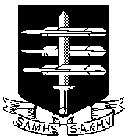 The South African
The South African
SAMHSEC had two purposes in visiting Bathurst, a small town situated 13 km inland from Port Alfred and famous for its associations with the 1820 Settlers. The first was to learn more about the military history of Bathurst; the other was to sample its rich Settler history. Many events scheduled for 2020 to mark the bicentenary of the Settlers. arrival had to be called off because of the Covid-19 pandemic. The Bathurst field trip was seen as an opportunity to make up in a small way for this misfortune.
Around 30 participants, members of SAMHSEC and others, made the journey from Port Elizabeth (now Gqeberha) for the field trip. They were joined by a handful of enthusiasts from Bathurst village itself, nearby farms and Grahamstown (now Makhanda). The first port of call was the Methodist Church, known as the Wesleyan Chapel on its completion in 1832 when services began there. A Methodist elder, Tom Penlington, gave a talk on its history.
Next was the St John's Anglican Church, where Maryna Shepherd, a Church Warden, explained its rich history. The Romanesque-style building, reminiscent of an English parish church, was designed by Colonel Charles Michell, the multi-talented first Surveyor-General of the Cape Colony. It was completed just before the outbreak of the Sixth Frontier War in 1834/5, when Xhosa forces attacked homes and farms around Bathurst. St John's therefore ser ved as a refuge for Settlers who'd fled from their homes, even before the first service could be held there. During this war, the church was a strong-point in Bathurst's defensive system, with earth works being constructed, all the windows blocked up and troops stationed around it; it was integrated with the Bathurst Military Post a few hundred metres above (see box).
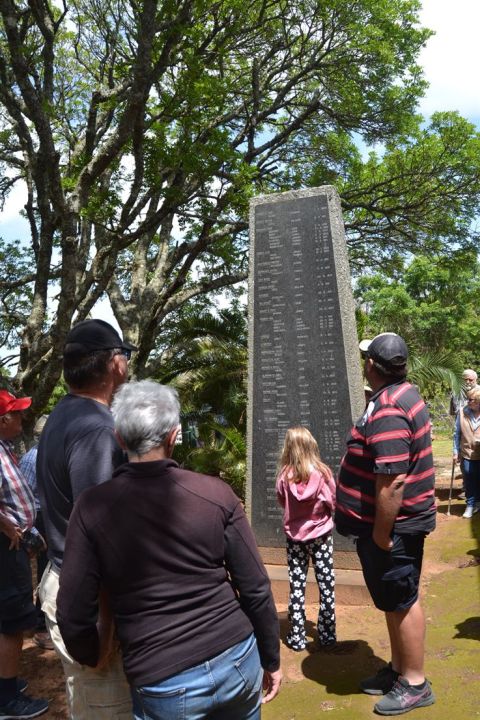
Trip participants study a monument
in the St John's church garden which
bears the names of men in the congregation
who were killed fighting alongside regular
British forces in the Sixth, Seventh
and Eighth Frontier Wars(1).
Later wars also left their mark at St John's. Plaques inside the church honour men from the congregation who died in the brief Basutoland campaign of 1880, at Delville Wood and in German East Africa during World War I, as well as an SAAF pilot killed in World War II.
St John's was dubbed The Fortress of Faith in a 1985 booklet by Shirley Krsic.
The field trip group then moved to Bathurst's most obvious military feature, the Powder Magazine, which stands on a knoll once known as Battery Hill. This stone building is the only surviving feature of what was the Bathurst Military Post from 1820 up to the 1860s. The layout of the former Military Post was explained by prominent local historian Rod Hooper-Box and Basil Mills (well known for staging historical reenactments on his farm and other varied initiatives), using a diagram attached to the Powder Magazine wall. David Forsdyke of the local history society, Historic Bathurst, took members to view the traces of trenches and fortifications remaining in the bush around the knoll.
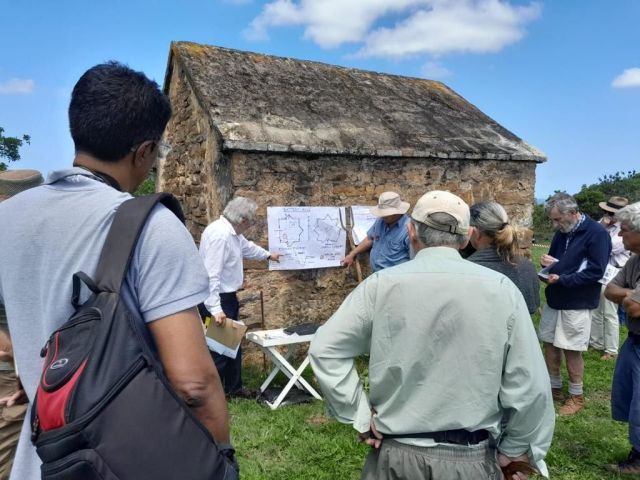
At the Powder Magazine, Rod Hooper-Box explains points on his diagrams of the Star Forts.
Barracks were built at the Bathurst Military Post from November 1820. By December, the powder magazine was being built. A statement from 1838 shows that the post included two star forts about 19 metres square with redans (triangular extensions), barracks housing a sergeant and 30 other troops, a cookhouse and a guardroom, as well as the powder magazine. British Army units known to have been stationed at the Post up to 1864 were: the 72nd Duke of Albany's Own Highlanders, the 6th Warwickshire Regiment of Foot, the 78th Highlanders (later re-designated Seaforth's) and the 73rd Regiment of Foot (Perthshire); while a detachment of the Cape Corpsor Cape Mounted Rifles were housed in huts further down the hill for much of this period; and 250 Fingo troops from King William's Town are also mentioned. Except for the powder magazine which was of stone, all the buildings were made of wattle and daub. The Bathurst Military Post was abandoned in 1864, when the Xhosas had ceased to be a threat and the Colony's eastern frontier area was securely occupied.
(Summarised from Rod Hooper-Box's presentation and his article in the Lower Albany History Society Journal).
Lunch break followed, during which several members dined at the 191-year old 'Pig', as the hostelry is affectionately known. Jeremiah Goldswain once owned the Bathurst Inn, as it was known for its first century. The origin of the name 'Pig and Whistle' has a strong military connection. During World War II, the RAF established its 43 Air School between Bathurst and Port Alfred(2). Trainee pilots deployed around the then Empire had a habit of naming the pubs they frequented while off duty, after their 'locals' back in England. In this way a traditional pub name was exported to Bathurst, and being so in keeping with its 'English village' character, the name stuck.
Some trip participants joined Nick Cowley on a Historical Walking Trail around Bathurst's original core. This passed several Settler-era buildings, including the Old Drostdy(3) and Bathurst Primary School, which has a claim to be the oldest in the country(4).
After lunch the field trip moved on to the Toposcope, on a hill just outside Bathurst which offers panoramic views. The real historical feature here is Bailey's Beacon, erected by Captain William Bailey of the Royal Engineers during surveys he conducted along the entire Cape Colony coast around 1859. The Beacon, a stone and concrete mound, is surrounded by the Toposcope - a circular wall built in 1968 to house plaques indicating the locations where the various Settler parties were set down and established themselves. Each plaque faces in the direction of a Settler party location and gives details of the distance, the party leader's name, place where the party originated in the United Kingdom, and the ship that carried them to Algoa Bay (now Mandela Bay). David Forsdyke explained how Historic Bathurst had refurbished the entire site after considerable damage by vandals, replacing the earlier metal and glass plaques with granite. Mounds have also been erected honouring Frontier War-era Xhosa amakhosi in the area, some of whom fought against the British and colonial forces, which included many Settler men.
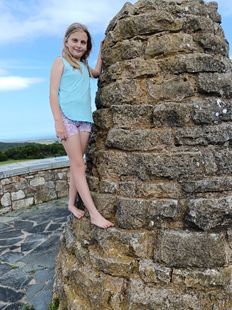
The youngest participant in the field trip,
nine-year-old Settler descendant Isabella Newcombe,
climbs Bailey's Beacon, symbolising the continuity
of Settler presence in Frontier Country. Her family
still lives on the same farm after two centuries,
not uncommon for Settler families in the area.
Photo by permission of Isabella herself
and her father Mike Newcombe, both
descended from Settler Robert Newcombe (1782-1862)
The outing concluded at Bradshaw's Mill, South Africa's oldest water-powered textiles mill. David Forsdyke explained its history, and also opened the millrace, fed by a nearby dam, to allow the rushing water to set the mill's large wooden wheel in motion. The oldest part of the mill dates back to the late 1820s, when it was built by Settler brothers Samuel and Richard Bradshaw. Sam Bradshaw went on to become a Field Cornet in the local militia, serving in the Frontier Wars as well as the frequent pursuits of cattle reivers and skirmishes that punctuated the wars.
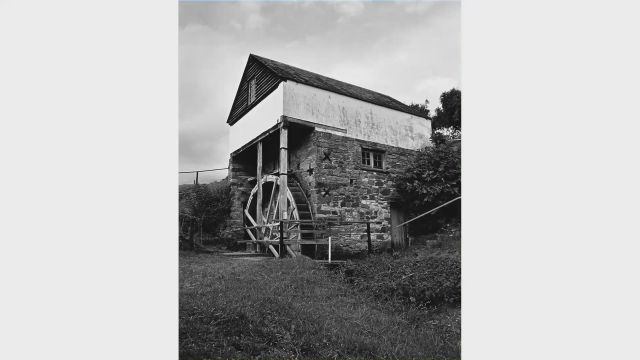
Bradshaw's Mill showing the wooden water wheel.
The highly successful and enjoyable field trip saw participants learning a good deal about the 1820 Settlers' and Bathurst's history, as well as absorbing the village's unique ambience.
SAMHSEC made generous donations to both the historic churches visited, while trip participants contributed individually to Historic Bathurst's expenses involved in maintaining the Powder Magazine, Toposcope and Mill. SAMHSEC extended its thanks and appreciation to Historic Bathurst for their help and collaboration on the day, as well as their devoted upkeep of significant Settler-linked sites.
Bathurst was established in 1820 specifically to serve as an administrative seat for the eastern frontier area of the Cape Colony, where the British population received a sudden boost that year of about 4000 government-sponsored immigrants - who would become known as the [1820] Settlers. Bathurst, however, lost that status (adminstrative seat) to Grahamstown only a year later. This meant that Bathurst's growth took place only very slowly and it retained a certain 'English village' character, which to some extent persists even today. It came under attack during the Frontier Wars, as explained in the main text. A handful of Settler-era buildings still survive, including the almost legendary Historic Pig and Whistle Inn and the two churches visited on the trip.
NOTES
About the Author
Nick Cowley 'semigrated' from Gauteng on his retirement from the SABC.
Prior to Covid-19's intervention, he had notably entertained the Society's Johannesburg meetings with sing-along presentations of songs from the First and later the Second World Wars.
While in Johannesburg he had organised several musical evenings at the Ditsong Museum which had the audience singing along happily to songs of the First and later Second World wars.
He has delivered a few Zoom lectures since moving to Bathurst.
Front Cover Photograph:
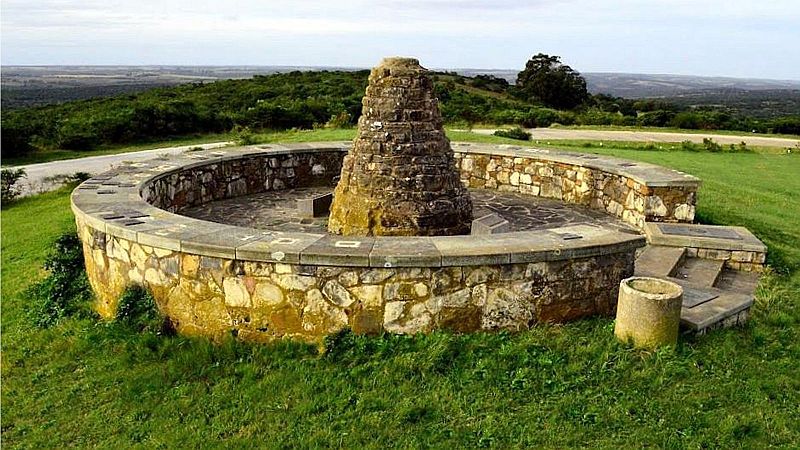
The toposcope built around Bailey's Beacon near Bathurst
in the Eastern Cape. The Beacon was erected in 1859;
it was on the site of the camp from which the 1820 Settler
allotments were distributed. In 1968 the toposcope was added
with pointers to where each of the immigrant parties were settled.
It was one of the National Monuments visited by members and guests
on the SAMHSEC field trip, as related by Nick Cowley.
Return to Journal Index OR Society's Home page
South African Military History Society / scribe@samilitaryhistory.org